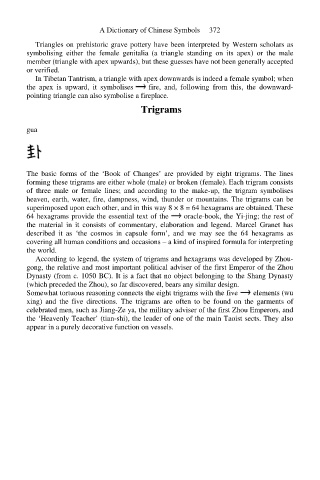Page 379 - A Dictionary of Chinese Symbols BIG Book
P. 379
A Dictionary of Chinese Symbols 372
Triangles on prehistoric grave pottery have been interpreted by Western scholars as
symbolising either the female genitalia (a triangle standing on its apex) or the male
member (triangle with apex upwards), but these guesses have not been generally accepted
or verified.
In Tibetan Tantrism, a triangle with apex downwards is indeed a female symbol; when
the apex is upward, it symbolises fire, and, following from this, the downward-
pointing triangle can also symbolise a fireplace.
Trigrams Trigrams
gua
The basic forms of the ‘Book of Changes’ are provided by eight trigrams. The lines
forming these trigrams are either whole (male) or broken (female). Each trigram consists
of three male or female lines; and according to the make-up, the trigram symbolises
heaven, earth, water, fire, dampness, wind, thunder or mountains. The trigrams can be
superimposed upon each other, and in this way 8 × 8 = 64 hexagrams are obtained. These
64 hexagrams provide the essential text of the oracle-book, the Yi-jing; the rest of
the material in it consists of commentary, elaboration and legend. Marcel Granet has
described it as ‘the cosmos in capsule form’, and we may see the 64 hexagrams as
covering all human conditions and occasions – a kind of inspired formula for interpreting
the world.
According to legend, the system of trigrams and hexagrams was developed by Zhou-
gong, the relative and most important political adviser of the first Emperor of the Zhou
Dynasty (from c. 1050 BC). It is a fact that no object belonging to the Shang Dynasty
(which preceded the Zhou), so far discovered, bears any similar design.
Somewhat tortuous reasoning connects the eight trigrams with the five elements (wu
xing) and the five directions. The trigrams are often to be found on the garments of
celebrated men, such as Jiang-Ze ya, the military adviser of the first Zhou Emperors, and
the ‘Heavenly Teacher’ (tian-shi), the leader of one of the main Taoist sects. They also
appear in a purely decorative function on vessels.

